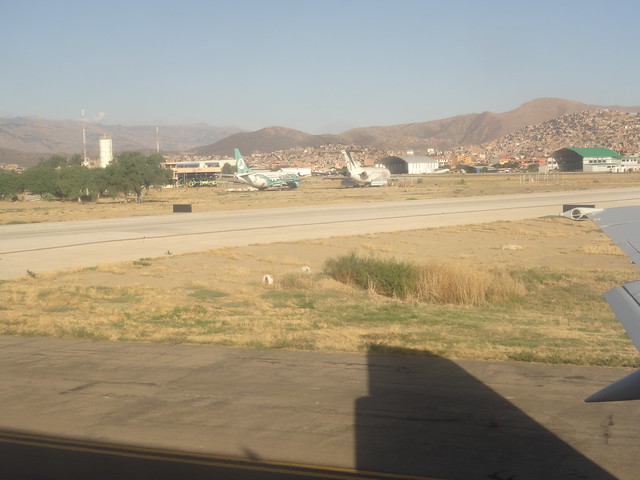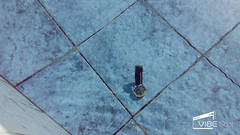Cochabamba
Cochabamba (Aymara: Quchapampa; Quechua: Quchapampa) is a city and municipality in central Bolivia in a valley in the Andes mountain range. It is the capital of the Cochabamba Department and the fourth largest city in Bolivia, with a population of 630,587 according to the 2012 Bolivian census. Its name is from a compound of the Quechua words qucha "lake" and pampa, "open plain." Residents of the city and the surrounding areas are commonly referred to as cochalas or, more formally, cochabambinos.
It is known as the "City of Eternal Spring" or "The Garden City" because of its spring-like temperatures all year round. It is also known as "La Llajta," which means "town" in Quechua. It is the largest urban center between the higher capital of La Paz and Santa Cruz de la Sierra in the tropical plains of the east. It sits south-west of the Tunari mountains, and north of the foothills of the Valle Alto. In antiquity, the area featured numerous lakes, which gave the city its name. Many of these lakes have since disappeared to urban development, but Coña Coña and Alalay lakes are extant examples. It has been a populated settlement since the Pre-Inca period, and is today an important cultural, educational, political, and commercial centre.
History
Pre-Inca and Inca
The Cochabamba valley has been inhabited for thousands of years due to its fertile productive soils and mild climate. Archaeological evidence suggests that the initial inhabitants were of indigenous ethnic groups: Tiwanaku, Tupuraya, Mojocoya, Omereque, and Inca inhabited the valley at times before the Spanish arrived.
The area got its name from Quechua Kochaj-pampa, as part of the Inca civilization. The area was conquered by Topa Inca Yupanqui (ruled 1471–1493). His son Huayna Capac turned Cochabamba into a large production enclave or state farm to serve the Incas. The local population was possibly depleted during the Inca conquest and Huayna Capac imported 14,000 people, called mitimas, to work the land. The principal crop was maize which could not be grown in much of the high and cold heartland of the Inca Empire. The maize was stored in 2,400 storehouses (qollqas) in the hills overlooking the valley or transported by llama caravan to storage sites in Paria, Cusco, of other Inca administrative centres. Most of the maize was probably used to sustain the Inca army during its campaigns.
Spanish and Bolivian
The first Spanish inhabitant of the valley was Garci Ruiz de Orellana in 1542. He purchased the majority of the land from local tribal chiefs Achata and Consavana through a title registered in 1552 at the Imperial City of Potosí. The price paid was 130 pesos. His residence, known as the House of Mayorazgo, stands in the Cala Cala neighbourhood.
The city, called Villa de Oropesa, was founded on 2 August 1571 by order of Viceroy Francisco de Toledo, Count of Oropesa. It was to be an agricultural production centre to provide food and wood for the mining towns of the relatively nearby Altiplano region, particularly Potosí which became one of the largest and richest cities in the world during the 16th and 17th centuries — funding the vast wealth that ultimately made Spain a world power. In fact, anthropologist Jack Weatherford and others have cited the city of Potosí as the birth of capitalism because of the money and materialism it provided Spain. Thus, with the silver mining industry in Potosí at its height, Cochabamba thrived during its first centuries. However, the city entered a period of decline during the 18th century as mining began to wane.
In 1786, King Charles III of Spain renamed the city the 'loyal and valiant' Villa of Cochabamba. This was done to commend the city's pivotal role in suppressing the indigenous rebellions of 1781 in Oruro by sending armed forces to Oruro to quell the uprisings. Since the late 19th century it has again been generally successful as an agricultural centre for Bolivia.
The 1793 census shows that the city had a population of 22,305 persons. There were 12,980 mestizos, 6,368 Spaniards, 1,182 indigenous natives, 1,600 mulattos and 175 African slaves.
In 1812, Cochabamba was the site of a riot against the Spanish Army. On May 27, thousands of women took up arms against the Spanish. According to historian Nathaniel Aguirre: "From Cochabamba, many men have fled. Not one woman. On the hillside, a great clamour. Cochabamba's plebeian women, at bay, fight from the centre of a circle of fire. Surrounded by five thousand Spaniards, they resist with battered tin guns and a few arquebuses; and they fight to the last yell, whose echoes will resound throughout the long war for independence. Whenever his army weakens, General Manuel Belgrano will shout those words which never fail to restore courage and spark anger. The general will ask his vacillating soldiers: Are the women of Cochabamba present?"To celebrate their bravery, Bolivia now marks May 27 as Mother's Day.
In 1900, the population was 21,886.
Besides a number of schools and charitable institutions, the Catholic diocese has 55 parishes, 80 churches and chapels, and 160 priests.
Water War
In 1998, the International Monetary Fund (IMF) agreed to give Bolivia a loan of $138 million to control inflation and promote economic growth. However, it only agreed to do so on the condition that Bolivia sell "all remaining public enterprises," including its national oil refineries and the local water company, SEMAPA. In 1999, a group of private investors, specifically the Bechtel Corporation with headquarters in San Francisco, California, United States of America, came together under the name of Aguas del Tunari and bought the rights for the privatization of the city's water. In that same year, the World Bank (WB) refused to subsidize the water to help lower the cost for the people. Then in 2000, the people of Cochabamba began to protest as water priced hiked to a 50% increase that the majority could not afford. The Coalition for the Defense of Water and Life, and its leader Oscar Olivera, started a demonstration in
La Plaza 14 de Septiembre also known as La Plaza Principal. The march was meant to be peaceful, but after two days the police used tear gas against the protestors and injured about 175 people and killed 1 and blinded two. Soon after, news reports were made about the protests and the violence. The Defense of Water and Life held an unofficial referendum and 96% of 50,000 people wanted Aguas del Tunari's contract to terminate, but the government refused. The protests only grew and the entire world began to watch forcing Bechtel to leave its contract and return SEMAPA to the public. Bechtel as well tried to sue the Bolivian government for $50 million but it withdrew its claim shortly after. This event was soon labelled as the Water Wars and became a driving force for anti-globalization projects such as the UN's decision to make water sanitation a human right and the privatisation of water as unethical in 2010. Additionally, the Water Wars would help spark the next revolt against the privatisation of natural gases from 2003 to 2005 which would lead to the removal of two presidents, Gonzalo Sánchez de Lozada and Carlos Mesa, and the rise of President Evo Morales in 2006.
In January 2007, city dwellers clashed with mostly rural protestors, leaving four dead and over 130 injured. The first democratically elected Prefect of Cochabamba, Manfred Reyes Villa, had allied himself with the leaders of Bolivia's Eastern Departments in a dispute with President Evo Morales over regional autonomy and other political issues. The protestors blockaded the highways, bridges, and main roads, having days earlier set fire to the departmental seat of government, trying to force the resignation of Reyes Villa. Citizens attacked the protestors, breaking the blockade and routing them, while the police did little to stop the violence. Further attempts by the protestors to reinstate the blockade and threaten the government were unsuccessful, but the underlying tensions had not been resolved.
In July 2007, a monument erected by veterans of January's protest movement in honour of those killed and injured by government supporters was destroyed in the middle of the night, reigniting racial conflicts in the city.
In August 2008, a nationwide referendum was held. The prefect of Cochabamba, Manfred Reyes Villa, was not confirmed by the voters of the department. The mayor of Cochabamba in 2018 is José María Leyes.
People and culture
Cochabamba is known as the heart of Bolivia and the gastronomic capital. Traditional cuisine includes: salteñas, chuño, tucumanas, pique macho, silpancho, anticucho, sopa de mani, chicharrón, charke, fricasé, rellenos de papa and many more dishes.
The international street art festival known as the BAU (Bienal de Arte Urbano) has been hosted in Cochabamba every two years since 2011. The festival is organized by , a local cultural centre. In 2011, 2013, 2015, and 2017 the painting was done in the Villa Coronilla, and Geronimo de Osorio neighbourhoods. In 2019 the festival focused on the neighbourhood Esperanza, on the edge of the Alalay Lake. The festival has featured internationally renowned artists such as Blu (Italy) and Inti (Chile).
Commensurate with other large cities in the Andean highlands of South America, Cochabamba is a city of contrasts. Its central commercial districts, Zona Norte, is bounded by Plaza Colón and Plaza 14 de Septiembre, are generally equipped with modern urban amenities and are where the majority of the city's formal business and commercial industries are based. La Cancha, the largest open-air market in South America, is also an active place where locals can buy a range of items. An active nightlife is centered around Calle España and along the broad, tree-lined boulevard, El Prado. In contrast, the Zona Sur, a remote area adjacent to the Wilstermann International Airport is visibly impoverished, with adobe homes and unpaved roads, which is often the first impression visitors acqui…
Looking for places related to Cochabamba?
Those are other destinations to find places related to Cochabamba:






















